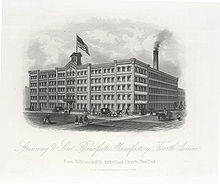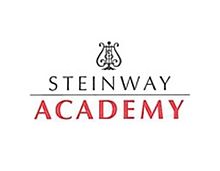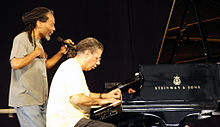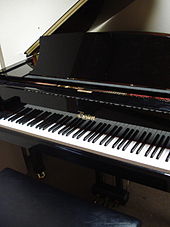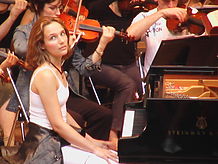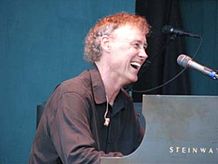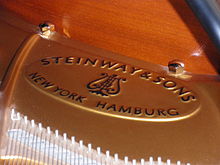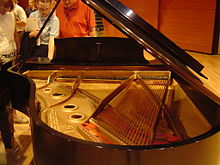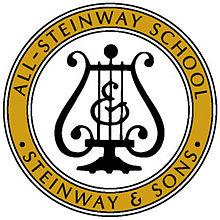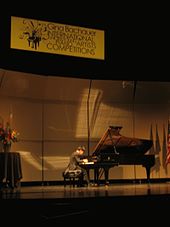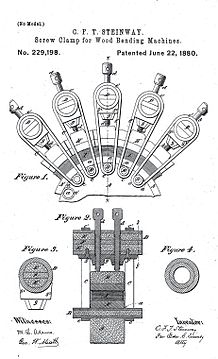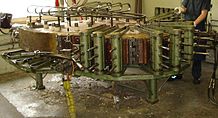- Steinway & Sons
-
"Steinway" redirects here. For other uses, see Steinway (disambiguation).
Steinway & Sons 
Type Private (subsidiary of Steinway Musical Instruments)[1] Industry Musical instruments Founded March 5, 1853[2] Founder(s) Heinrich Engelhard Steinweg[3]
(later Henry E. Steinway) (1797–1871)Headquarters New York City, the United States[4]
40°46′45″N 73°53′59″W / 40.7793°N 73.8998°W
Hamburg, Germany[4]
53°34′27″N 9°55′27″E / 53.5743°N 9.9241°ENumber of locations Worldwide around 200 authorized dealers[5] Area served Worldwide[5] Key people Thomas Kurrer[6]
President, Worldwide (since 2008)
Ron Losby[6]
President, Americas (since 2008)Products Grand pianos[7][8]
Upright pianos[9][10]Production output Yearly around 4,000 new pianos[11] Services Restoration of Steinway pianos[12] Parent Steinway Musical Instruments, Inc.[1] Website www.steinway.com
www.steinway.deSteinway & Sons, also known as Steinway
 i/ˈstaɪnweɪ/, is an American and German manufacturer of handmade[13] pianos, founded 1853 in Manhattan in New York City by German immigrant Heinrich Engelhard Steinweg (later Henry E. Steinway).[14] The company's growth led to the opening of a factory and company town in what is now the Astoria section of Queens in New York City and the opening of a factory in Hamburg, Germany.[15] Steinway is a prominent piano company,[16][17] known for making pianos of high quality[18][19] and for its influential inventions within the area of piano development.[20][21] The company holds a royal warrant by appointment to Queen Elizabeth II.[22]
i/ˈstaɪnweɪ/, is an American and German manufacturer of handmade[13] pianos, founded 1853 in Manhattan in New York City by German immigrant Heinrich Engelhard Steinweg (later Henry E. Steinway).[14] The company's growth led to the opening of a factory and company town in what is now the Astoria section of Queens in New York City and the opening of a factory in Hamburg, Germany.[15] Steinway is a prominent piano company,[16][17] known for making pianos of high quality[18][19] and for its influential inventions within the area of piano development.[20][21] The company holds a royal warrant by appointment to Queen Elizabeth II.[22]Steinway pianos have been recognized with numerous awards.[23] One of the first official recognitions was a gold medal won in 1855 at the American Institute Fair at the New York Crystal Palace just two years after the company's foundation.[24] In 1855–62 Steinway pianos received 35 gold medals.[23] Several awards and recognitions have followed,[25] including 3 medals at the 1867 Exposition Universelle in Paris.[26] Steinway is granted around 130 patents in piano making.[27][28][29]
Other than the expensive Steinway & Sons piano brand, Steinway designs and markets two budget brands: Boston and Essex. The Boston and Essex pianos are made using lower-cost components and labor and are produced in Asia by other piano manufacturers.[30][31][32]
Contents
History
Foundation and growth
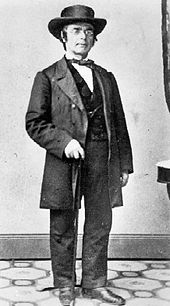 Studio photo of Heinrich Engelhard Steinweg taken by the noted photographer Mathew Brady
Studio photo of Heinrich Engelhard Steinweg taken by the noted photographer Mathew Brady
Heinrich Engelhard Steinweg, piano maker of the Steinweg brand, emigrated from Germany to America in 1850 with his wife and six of their seven children.[33] The son Christian Friedrich Theodor Steinweg remained in Germany, and continued making the Steinweg brand of pianos. In 1853, Heinrich Engelhard Steinweg founded Steinway & Sons. His first workshop was in a small loft at the back of 85 Varick Street in Manhattan, New York City.[34] The first piano produced by Steinway & Sons was given the number 483 because Steinweg had built 482 pianos in Germany before founding the company. Number 483 was sold to a New York family for $500, and is now displayed at the Metropolitan Museum of Art in New York City.[35] A year later, demand was such that the company moved to larger premises at 82–88 Walker Street. It was not until 1864 that the family anglicized their name from Steinweg to Steinway.[36]
By the 1860s, Steinway had built a new factory and lumber yard. With a workforce of 350 men, production increased from 500 to 1,800 pianos per year. The pianos themselves underwent numerous substantial improvements through innovations made both at the Steinway factory and elsewhere in the industry based on emerging engineering and scientific research, including developments in the understanding of acoustics.[37] Almost half of the company's around 130 patented inventions were developed by the first and second generations of the Steinway family. Steinway's pianos won several important prizes at exhibitions in New York City, Paris and London.[38][39] By 1862, Steinway pianos had received more than 35 medals in the United States alone.[23][25]
Around 1870–80, William Steinway established a professional community, the company town Steinway Village, in what is now the Astoria section of Queens in New York City.[15] Steinway Village was built as its own town, and included a new factory (still used today) with its own foundries, post office, parks and housing for employees. Steinway Village later became part of Long Island City. Steinway Street, one of the major streets in the Astoria and Long Island City neighborhoods of Queens, is named after the company.[40]
To reach European customers who wanted Steinway pianos, and to avoid high European import taxes, William Steinway and Theodore Steinway established a new piano factory in the free German city of Hamburg in 1880.[37] The first address of Steinway's factory in Germany was at Schanzenstraße in the western part of Hamburg St. Pauli. Theodore Steinway became the head of the German factory, and William Steinway went back to the factory in New York City. The Hamburg and New York City factories regularly exchanged experience about their patents and technique despite the large distance between them, and they continue to do so today. More than a third of Steinway's patented inventions are under the name of Theodore Steinway.[41]
In 1890, Steinway received their first royal warrant, granted by Queen Victoria.[42][43] The following year the patrons of Steinway included the Prince of Wales and other members of the monarchy and nobility.[42] In subsequent years Steinway was granted royal and imperial warrants from the rulers of Italy, Norway, Persia, Portugal, Romania, Russia, Spain, Sweden and Turkey.[44]
Steinway Halls / Steinway-Häuser
Main article: Steinway Hall Crowd of spectators buying tickets for a Charles Dickens reading at the Steinway Hall in New York City in 1867
Crowd of spectators buying tickets for a Charles Dickens reading at the Steinway Hall in New York City in 1867
Steinway Hall (German: Steinway-Haus) is the name given to buildings housing concert halls, showrooms and sales departments for Steinway pianos. In 1864 William Steinway, the son of Henry E. Steinway who is credited with establishing Steinway's remarkable success in marketing, built a set of elegant new showrooms housing more than 100 pianos on East 14th Street in Manhattan, New York City. In 1866, William Steinway oversaw the construction of the first Steinway Hall to the rear of the showrooms. The Steinway Hall seated more than 2,000 and quickly became an important part of New York City's cultural life, housing the New York Philharmonic for the next 25 years until Carnegie Hall opened in 1891.[45] Concertgoers had to pass through the piano showrooms; this had a remarkable effect on sales, increasing demand for new pianos by four hundred in 1867 alone.[46] The Steinway factory was then on Fourth Avenue (now Park Avenue) and East 55th Street in Manhattan.
In 1880, a Steinway-Haus was established in Hamburg as a sales showroom with concert halls, practice studios, sales departments and piano storage space. In 1909, another Steinway-Haus opened in Berlin. A Steinway-Haus is similar to a Steinway Hall. Further concepts developed by the company include Steinway Piano Galleries, Homes of Steinway, Steinway Rooms and Steinway Salons. Today Steinway Halls and Steinway-Häuser are located in world cities such as New York City,[47] London,[48] Berlin[49] and Vienna.[50]
Expansion
By 1900, Steinway factories produced more than 3,500 pianos a year. In 1857 Steinway began to produce a line of highly lucrative art case pianos, designed by well-known artists. These pianos today command high prices in auctions around the world.[52][53][54] In 1903 the 100,000th Steinway grand piano was given as a gift to the White House; it was decorated by the artists Thomas Wilmer Dewing and Maria Oakey Dewing under the supervision of the head of Steinway's Art Piano Department, Joseph Burr Tiffany. The 100,000th Steinway grand piano was replaced in 1938 by the 300,000th, which remains in use in the White House.[55][56] The piano is normally placed in the largest room of the White House, the East Room.[57] The 2002 White House Christmas Card features this piano.[58]
Harold Bauer playing Saint-Saëns' Piano Concerto No. 2 in G minor, Op. 22, excerpt of 3rd movement. Duo-Art recording 5973-4 played on a Steinway grand piano model XR 6'2" Duo-Art from 1920.
Later Steinway diversified into the manufacture of player pianos. Several systems such as the Welte-Mignon, Duo-Art, and Ampico were incorporated. During the 1920s Steinway had been selling up to 6,000 pianos a year. In 1929, Steinway constructed one double-keyboard grand piano. It had 164 keys and four pedals. (In 2005, Steinway refurbished this instrument).[59] After 1929, piano production went down, and during the Great Depression, Steinway produced only a little more than 1,000 pianos per year. In the years between 1935 and World War II, demand rose again.
During World War II the Steinway factory in New York City received orders from the Allied Armies to build wooden gliders to convey troops behind enemy lines. Few normal pianos could be made, but some 3000 special models were built by Steinway, the Victory Vertical or G.I. Piano. It was a small piano, able to be lifted by four men, painted olive drab, gray or blue, designed to be carried aboard ships or dropped by parachute from an airplane, in order to bring music to the soldiers.[60]
The factory in Hamburg, Germany, being American-owned, could sell very few pianos during World War II. No more than a hundred pianos per year left the factory. In the later years of the war, the company was ordered to give away all the prepared and dried wood from the lumber yard, to be used for war production. In an air raid over Hamburg, the factory was hit by several Allied bombs and was nearly destroyed. After the war, Steinway completed the restoration of the Hamburg factory with some help from the Marshall Plan.[61] Eventually, the post-war cultural revival boosted demand for entertainment and Steinway increased piano production at the New York City and Hamburg factories, going from 2,000 in 1947 to 4,000 pianos a year by the 1960s.
In 1972, after a long-running financial struggle, legal issues with the Grotrian-Steinweg brand, and a lack of business interest among some of the Steinway family members, the firm was sold to CBS. At that time CBS owned many enterprises in the entertainment industry, including guitar maker Fender, electro-mechanical piano maker Rhodes, and the baseball team New York Yankees. CBS had plans to form a musical conglomerate that made and sold music in all forms and through all outlets, including records, radio, television, and musical instruments.[62] This new conglomerate was evidently not as successful as CBS had expected, and Steinway was sold in 1985, along with classical and church organ maker Rodgers and flute and piccolo maker Gemeinhardt, to a group of Boston-area investors.[62][63] These investors founded the musical conglomerate Steinway Musical Properties (later Steinway Musical Instruments, a publicly traded company (NYSE: LVB)), which is the parent company of Steinway.
In 1995, Steinway Musical Properties, parent company of Steinway, merged with the Selmer Company to form Steinway Musical Instruments, which acquired the flute manufacturer Emerson in 1997, then piano keyboard maker Kluge in 1998, and the Steinway Hall in 1999.[64] The conglomerate made more acquisitions in the following years. Since 1996, Steinway Musical Instruments has been traded at the New York Stock Exchange (NYSE) under the abbreviation LVB, for Ludwig van Beethoven. The Korean piano and guitar maker Samick Music Corporation is the largest shareholder, controlling 33% of Steinway stock;[65] Samick Chairman Jong Sup Kim has been a member of the Steinway board of directors since November 2009.[66]
Recent history
In 1973, British Prime Minister Edward Heath bought a Steinway piano with the £450 he had won in the Charlemagne Prize for leading Britain into the European Economic Community. He placed the piano at 10 Downing Street.[67]
In 1988, Steinway made its 500,000th piano. The piano was designed by artist Wendell Castle.[68] All the 800-plus Steinway Artists signed the piano with their names,[69] including Vladimir Horowitz and Sir Elton John.[70] The piano is taking an extended global concert tour.[70][71]
In 1994, Steinway opened the C.F. Theodore Steinway Academy For Concert Technicians, also known as the Steinway Academy; the world's first academy for concert technicians worldwide.[72] Georges Ammann, concert technician with Steinway's factory in Hamburg, said, "We were getting a lot of complaints from pianists all over the world – they said that getting their pianos tuned was a disastrous process every time and that the local technicians were hopeless. The artists kept begging us to do something about this ... From that perspective, it was clear that an institution like the Steinway Academy was a necessity."[73] The Steinway Academy provides professional concert technicians with a two-week intensive course..[73]
Steinway is a member of the Luxury Marketing Council founded 1994,[74] a cooperative marketing organization aimed at affluent buyers.
By the year 2000, Steinway had made its 550,000th piano. The company updated and expanded production of its two other brands, Boston and Essex pianos, in addition to the flagship Steinway & Sons. More Steinway Halls, Steinway Piano Galleries, Homes of Steinway, Steinway Rooms and Steinway Salons opened across the world, mainly in China, Japan and Korea.
In 2003, Steinway celebrated its 150th anniversary at Carnegie Hall's largest auditorium, Isaac Stern Auditorium, with a gala series of three concerts on June 5, 6 and 7, 2003.[75] The concert on June 5 featured classical music with Kit Armstrong (a music child prodigy), Van Cliburn, Eroica Trio, Gary Graffman, Ben Heppner, Yundi Li and Güher and Süher Pekinel. The host was Charles Osgood. On June 6 was a concert of jazz featuring Peter Cincotti, Herbie Hancock, Ahmad Jamal, Al Jarreau, Ramsey Lewis, Tisziji Muñoz, Chucho Valdés and Nancy Wilson, hosted by Billy Taylor. Pop music was the focus of June 7, with Paul Shaffer hosting performances by Art Garfunkel, Bruce Hornsby, k.d. lang, Michel Legrand, Brian McKnight, Peter Nero and Roger Williams. As part of the 150th anniversary, renowned international fashion designer Karl Lagerfeld created a commemorative Steinway art case piano.[76]
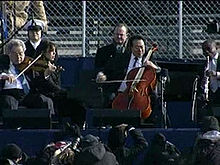 Gabriela Montero at a Steinway grand piano at the inauguration ceremony for US President Barack Obama on January 20, 2009[77][78]
Gabriela Montero at a Steinway grand piano at the inauguration ceremony for US President Barack Obama on January 20, 2009[77][78]
In April 2005, Steinway celebrated the 125th anniversary of the establishment of Steinway's factory in Hamburg, Germany. Steinway employees, together with artists, dealers and friends from around the world celebrated the anniversary at the Laeiszhalle (former Music Hall Hamburg) with a gala concert, culminating in a showcase performance by the Steinway Artists Lang Lang, Vladimir and Vovka Ashkenazy and Detlef Kraus. As part of the celebration, the 125th anniversary limited edition Steinway art case piano by renowned designer Count Albrecht von Goertz was presented to the public.[79]
Until his death on September 18, 2008 at the age of 93, Henry Z. Steinway, the great-grandson of the Steinway founder, still worked for Steinway and put his signature on custom-made limited edition pianos. At several public occasions, Henry Z. Steinway represented the Steinway family.[80] He started at the company in 1937 after graduating from Harvard University. He was president of the company in 1955–77 and was the last Steinway family member to be president of Steinway.[81]
On January 24, 2009, Steinway installed the world's largest[82] solar-powered rooftop air-conditioning and dehumidification system, at a cost of $875,000, to dehumidify the factory in New York City, and protect the pianos.[83] Lower humidity in the factory provides a more stable environment, with no moisture to threaten the construction of the pianos. The massive HVAC system will function as a beta test site for solar technology in the Tri-State Region.
After the 2008 economic downturn, Steinway grand piano sales fell by half and 30% of the union employees were laid off from the New York factory between August 2008 and November 2009.[32] Total piano sales of Steinway Musical Instruments, including Boston and Essex brands, were down 21% in 2009.[32]
Piano models
Steinway pianos are sold by a worldwide network of around 200 authorized Steinway dealers.[5]
Grands and uprights
Steinway produces the following models of grand pianos and upright pianos:[84][85]
Steinway's factory in New York City produces six models of grand piano and three models of upright piano.[7][9]
- Grand pianos: S-155, M-170, O-180, A-188, B-211, D-274
- Upright pianos: 4510 (Sheraton), 1098, K-52
Steinway's factory in Hamburg, Germany, produces seven models of grand piano and two models of upright piano.[8][10]
- Grand pianos: S-155, M-170, O-180, A-188, B-211, C-227, D-274
- Upright pianos: V-125, K-132
Special designs
Designers and artists such as Karl Lagerfeld,[76] Louis Comfort Tiffany[86] and Sir Lawrence Alma-Tadema[87] have created original designs for Steinway pianos. These specially designed pianos fall under the series Steinway Art Case Pianos or Steinway Limited Edition Pianos.
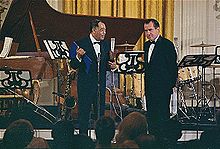 Composer and pianist Duke Ellington and US President Richard Nixon in front of the Steinway art case piano owned by the White House
Composer and pianist Duke Ellington and US President Richard Nixon in front of the Steinway art case piano owned by the White House
Steinway began creating art case pianos in 1857 and the making of art case pianos reached its peak in the late 19th century. Today, Steinway only builds art case pianos on rare occasions. The art case pianos are unique, because Steinway builds only one of each. Some of Steinway's most notable art case pianos are the Alma-Tadema grand piano from 1887, the 100,000th Steinway piano from 1903, the 300,000th Steinway piano from 1938 and the Sound of Harmony from 2008. The Alma-Tadema grand piano was designed by Sir Lawrence Alma-Tadema and received great public acclaim when it was exhibited in London.[88] The piano has a complicated hand-carved case, lid and legs and is decorated with paintings and 2,200 mother-of-pearl inlays.[87] It was bought by Henry Gurdon Marquand for his New York City mansion. In 1997, it was sold at Christie's auction house in London for $1.2 million, setting a price record for a piano sold at auction.[87] It is now displayed at the art museum Clark Art Institute.[88] The 100,000th Steinway piano was given as a gift to the White House in 1903 and is made of cherry tree with gold leaf. It is decorated with coats of arms of the thirteen original states of America and painted by Thomas Dewing with dancing figures representing the nine Muses. The 100,000th Steinway piano was replaced in 1938 by the 300,000th Steinway piano. The gold gilded mahogany legs of the 300,000th piano are carved as eagles and are moulded by sculptor Albert Stewart.[89] The piano remains in use in the White House.[57] The Sound of Harmony is decorated with inlays of 40 different woods, including the lid which replicates artwork by Chinese painter Shi Qi.[90] It took about four[91] years to build the grand piano and it was priced at €1.2 million.[90] The piano was chosen for use at the Expo 2010 Shanghai China.[91][92]
The series of limited edition pianos encompasses pianos of new designs and replicas of historic Steinway pianos. Examples of pianos of new designs include The S.L.ED by Karl Lagerfeld created to celebrate the 150th anniversary of the Steinway company in 2003,[76] and the 125th anniversary grand piano by Count Albrecht von Goertz designed to celebrate the 125th anniversary in 2005 of the foundation of the Steinway factory in Hamburg.[79] An example of replicas of historic Steinway pianos is the 150th anniversary grand piano, which are exact copies of the grand piano played by Ignacy Jan Paderewski on his famous United States concert tour in 1892–93.[93] Another example of replicas of historic Steinway pianos is the William E. Steinway grand piano, which are exact copies of the award-winning Steinway grand piano, that was exhibited at the Centennial Exposition in 1876.[94]
In 1999, Steinway introduced a new line of special designed pianos, the Steinway Crown Jewel Collection.[95] The collection consists of grand and upright pianos in Steinway's traditional design, but instead of the traditional ebony finish the pianos of the crown jewel collection are made in veneers of rare woods from around the world. The collection contains wood veneers such as Macassar ebony (The Ruby), East Indian rosewood (The Sapphire), kewazinga bubinga (The Opal) and Santos rosewood (The Emerald).
Piano brands
Other than the expensive Steinway & Sons brand, Steinway markets two budget brands: Boston for the mid-level market and Essex for the entry-level market. Boston and Essex pianos are made using lower-cost components and labor. These pianos are designed by Steinway but manufactured in Asia by other piano manufacturers.[30][31]
- Boston: made for the general piano market at lower prices than Steinway's name brand. Boston pianos are manufactured at the Kawai piano factory in Hamamatsu, Japan. Approximately 5,000 Boston pianos are built every year. There are five sizes of Boston grands and three sizes of Boston uprights available in a variety of finishes. Grand piano models are GP-156 PE, GP-163 PE, GP-178 PE, GP-193 PE and GP-215 PE. Upright piano models are UP-118E PE, (UP-118S PE), UP-126E PE and UP-132E PE. Boston grands feature a wider tail design (a feature of the Steinway models A, B, C and D) resulting in a larger soundboard area than conventionally-shaped pianos of comparable sizes.[30]
- Essex: cheaper than Steinway and Boston pianos. Essex pianos are made at the Pearl River piano factory in Guangzhou, China. There are two sizes of Essex grands and three to four sizes of Essex uprights available in a wide variety of finishes and furniture designs.[31]
"Piano bank"
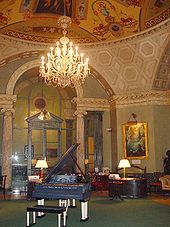 Steinway Hall in Manhattan, New York City
Steinway Hall in Manhattan, New York City
Steinway maintains a "piano bank" from which performing pianists, especially Steinway Artists, can select a Steinway piano for use in a certain concert, recording or tour.[96] The idea is to provide a consistent pool of Steinway pianos with various characteristics for performing pianists' individual touch and tonal preferences. Performing artists choose a piano for use at a certain venue after trying some of the pianos of the "piano bank". This allows a range of Steinway pianos with various touch and tonal characteristics to be available for artists to choose from.[96] Steinway takes responsibility for preparing, tuning and delivering the piano of the artist's choice to the designated concert hall or recording studio. The artist bears the cost of these services.[15] The pianos for the "piano bank" are selected by Steinway's experts.
The "piano bank" is worldwide and consist of more than 400 Steinway pianos,[96] mostly grand pianos model D-274. Approximately 300 pianos of the "piano bank" are located around the United States and are valued collectively at more than $25 million.[96][97] The headquarters of the "piano bank" is below street level in the basement of the Steinway Hall in Manhattan, New York City.[98]
Manufacture
New York City and Hamburg
Hélène Grimaud at a Steinway concert grand piano produced in Hamburg, GermanyBruce Hornsby performing on a Steinway concert grand piano produced in New York City, the United StatesGreat pianists of the past and some active pianists today have expressed a preference for Steinway pianos produced at Steinway's factory in New York City or at Steinway's factory in Hamburg. Vladimir Horowitz played a New York model D-274; Arthur Rubinstein preferred the Hamburg model D-274. Sergei Rachmaninoff owned two New York models in his Beverly Hills home and one New York model D-274 in his New York home; however, he chose a Hamburg model D-274 for his Villa Senar in Switzerland.[99] The difference between the New York and Hamburg Steinway pianos is less noticeable today.[100] Emanuel Ax, concert pianist and piano teacher at the prestigious[101] Juilliard School,[102] says that "... the differences have more to do with individual instruments than with where they were made."[100] Some visual differences are well known, for example: the New York models have a black satin finish and square or Sheraton corners; Hamburg models have a high gloss polyester finish and rounded corners.[100]
At present, 2,500 Steinway pianos are built in New York every year, and 1,500 are built in Hamburg. The market is loosely divided into two sales areas: the New York Steinway factory which supplies North and South America, and the Hamburg Steinway factory which supplies the rest of the world. At all main Steinway showrooms across the world, pianos can be ordered from both factories. The New York and Hamburg factories exchange parts and craftsmanship in order to "make no compromise in quality", in the words of Steinway's founder Henry E. Steinway.[103] Steinway parts for both factories come from the same places: Canadian maple is used for the rim, and the soundboards are made from Sitka spruce from Alaska. Both factories use similar crown parameters for their diaphragmatic soundboards. Steinway has acquired some of its suppliers in order to maintain high quality: the German manufacturer Kluge in Wuppertal, which supplies the keyboards, was bought in December 1998; in November 1999, Steinway purchased the company which supplies its cast iron plates, O.S. Kelly Co. in Springfield.[104]
Components
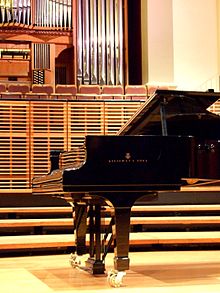 Steinway concert grand piano on the stage in Verbrugghen Hall, Sydney Conservatorium of Music – The University of Sydney, Australia
Steinway concert grand piano on the stage in Verbrugghen Hall, Sydney Conservatorium of Music – The University of Sydney, Australia
Each Steinway grand piano consists of more than 12,000 specific parts[12] assembled by 450 people.[105] A Steinway piano is handmade[13] and takes a year to build.[106]
Case
The cases of Steinway pianos are made of multiple laminations of hard rock maple.[107] Strong beams in the bottom of the grand pianos or in the backs of the vertical pianos provide additional support. The patented process used to make the Steinway rim called rim-bending was invented by Steinway in 1878.[108] The process is strictly adhered to today, more than 130 years later.[109] For braces and posts, Steinway pianos use spruce, a wood known for its tensile strength. After the rim-bending process, the rim has to "relax" from the tremendous shock of being bent. It is placed in a conditioning room between 10 and 16 weeks, depending on thickness and size of the rim. The room's temperature is set at 85°F (30°C) and the relative humidity is 45%.[109]
Plate
Inside the piano, a cast iron plate provides the strength to support the string tension of up to 20 tons.[111] The iron plate is installed in the case above the soundboard and is bronzed,[110] lacquered, polished, and decorated with the Steinway logo. In grand pianos, the iron plate, soundboard and strings are horizontal, while in vertical pianos, these three components are upright. Steinway fabricates plates in its own foundry using a sand-casting method.
Soundboard
The soundboard converts the vibration of the piano string into audible tones. Steinway crafts the soundboard from solid spruce, which allows the soundboard to transmit and amplify sound better than other woods.[112] The soundboard has a curved crown to provide the proper pressure against the string for maximum sound projection. Ribs are placed on the underside of the soundboard in order to maintain the crown, distribute tone along the soundboard, and provide strength. Steinway soundboards are made of close-grained, quarter-sawn Sitka spruce from British Columbia and Alaska. This wood is chosen for its acoustic qualities and is selected to be free of defects.[113] Individual pieces of spruce are matched to produce soundboards of uniform color and tonal quality. The soundboards found in Steinway pianos are double-crowned and feature Steinway's Diaphragmatic design. The Diaphragmatic Soundboard, patented by Steinway in 1936, features a soundboard that tapers in thickness from the center to the edges. This design permits freedom of movement and creates a richer, more lasting tonal response.[114]
Bridges
Soundboard bridges are glued to the top side of the soundboard to transmit vibrations from the strings to the soundboard. Steinway bridges are made of vertically-laminated hard rock maple with a solid maple cap.[113] They are bent to a specifically defined contour to optimize sound transmission. The bridge is measured for specific height requirements for each piano and is hand-notched for precise string bearing.[113] The bridges are then glued and doweled into the ribs to ensure the structural integrity of the entire soundboard.
Strings
On December 20, 1859, Patent No. 26,532 was granted to Steinway's founder, Heinrich Engelhard Steinweg, for the Overstrung Plate.[115] Treble strings are made of steel, and bass strings are made of copper-wound steel. The strings are all uniformly spaced with one end coiled around the tuning pins, which in turn are inserted in a laminated wooden block called the pin-block or wrestplank. The tuning pins keep the strings taut and are held in place by friction. The strings found on a Steinway piano are made of tensile Swedish steel.[116] The bass strings are wound with pure copper,[116] and the tuning pins are steel with rust resistant nickel-plating. Steinway also employs front and rear duplex scales. Steinway's relationship with Hermann von Helmholtz led to the development and Steinway patent in 1872 of front and back aliquots, allowing the traditionally-dead sections of strings to vibrate with other strings for a richer tone and longer sustain.[117]
Wrestplank/pinblock
The wrestplank is a multi-laminated block of wood into which the tuning pins are inserted. The wrestplank in Steinway pianos is made of hard rock maple, and the tuning pins are force-fitted into the pinblock to maintain the piano strings under extreme tension. The quality of the wrestplank is important in keeping the piano in tune. The Steinway Hexigrip Wrestplank pinblock, patented in 1963, is made from seven thick, quarter-sawn maple planks whose grain is oriented radially for evenly distributed end-grain exposure to the tuning pins.[116]
Keys and action
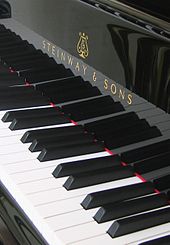 Keys of a Steinway grand piano
Keys of a Steinway grand piano
Each of Steinway's 88 keys is made of Bavarian spruce[116] with a polymer surface. The polymer key surfaces are more durable; the white keys do not yellow over time and are easier to replace than their ivory predecessors. Each of the keys transmits its movement to a small, felt-covered wooden hammer which strikes one, two or three strings when the note is played. The hammers are evenly aligned and have the ability to reset quickly and repeat any note rapidly. Dampers are felt-covered action parts which, when placed against the strings, dampen the vibration. The damper pedal raises all of the dampers, which allows sound to continue even after the key is released. The quarter-sawn maple action parts are mounted on a Steinway Metallic Action Frame, which consists of seamless brass tubes with rosette-shaped contours, force-fitted with maple dowels and brass hangers to ensure the stability of the regulation. In 1936, Steinway designed Accelerated Action in response to demands for a quicker-responding action. In 1962, Steinway introduced its Permafree action which used teflon parts in place of cloth bushings and were intended to withstand wear and humidity changes better than cloth. The teflon bushings resulted in certain unforeseen problems, however, and were discontinued after 1981.
Affiliates
Steinway Artists
 Steinway Artist Sergei Rachmaninoff at a Steinway grand piano
Steinway Artist Sergei Rachmaninoff at a Steinway grand piano
In contrast to other makers, who presented their pianos to pianists, William Steinway engaged the great Russian pianist Anton Rubinstein to play Steinway pianos during an American concert tour in 1872, with 215 concerts in 239 days. It was a triumph for both Rubinstein and Steinway.[118] Thus, the Steinway Artists program was born.[119] Later Ignacy Jan Paderewski played 107 concerts in just 117 days, traveling through America with his own railroad car and a Steinway concert grand piano.
 Steinway Artist Diana Krall performing on a Steinway grand piano
Steinway Artist Diana Krall performing on a Steinway grand piano
An author has estimated that more than 90% of concert grand pianos worldwide are from Steinway.[120] According to Steinway, 98% of the world's piano soloists chose to play publicly on a Steinway piano during the 2008–09 North American concert season,[121] and 99% during the 2002–03 worldwide concert season.[122] The majority of the world's concert halls have at least one Steinway concert grand piano model D-274, some (for example Carnegie Hall) have model D-274s from both the New York City factory and the Hamburg factory in order to satisfy a greater range of preferences.[120][123] Today more than 1,600[124] concert artists and ensembles bear the title Steinway Artist, which means that they have chosen to perform on Steinway pianos exclusively, and each owns a Steinway.[125] None are paid to do so.[125] Steinway Artists come from every genre: classical, jazz and pop. A few examples of Steinway Artists are Vladimir Ashkenazy, Harry Connick, Jr., Billy Joel, Evgeny Kissin, Diana Krall, Lang Lang, Roger Williams;[126][127] and a few examples of "immortals" are Benjamin Britten, Duke Ellington, George Gershwin, Vladimir Horowitz, Cole Porter, Sergei Rachmaninoff and Richard Rodgers.[127][128] Also piano ensembles are on the Steinway Artist list, for example Eroica Trio, Güher and Süher Pekinel, Katia and Marielle Labèque and The 5 Browns. These ensembles consist of pianists, who are all Steinway Artists.[129] In 2009, Steinway developed a new program for young artists, Young Steinway Artists. The title of Young Steinway Artist gives talented young pianists between the ages of 16 and 35 the opportunity of being affiliated with the Steinway Artist family, and access to the worldwide resources of Steinway and its network of dealers.[130]
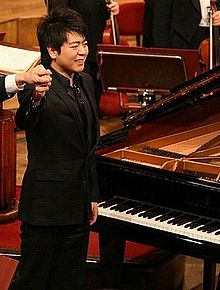 Steinway Artist Lang Lang next to a Steinway grand piano
Steinway Artist Lang Lang next to a Steinway grand piano
The Steinway Artists program has not been without opponents and controversy. Steinway expects Steinway Artists to perform on Steinway instruments where they are available and in appropriate condition, but can accept deviations.[131] Artur Schnabel complained once that "Steinway refused to let me use their pianos [i.e., Steinway pianos owned by Steinway] unless I would give up playing the Bechstein piano – which I had used for so many years – in Europe. They insisted that I play on Steinway exclusively, everywhere in the world, otherwise they would not give me their pianos in the United States. That is the reason why from 1923 until 1930 I did not return to America... In 1933,... Steinway changed their attitude and agreed to let me use their pianos in the United States, even if I continued elsewhere to play the Bechstein. Thus from 1933 on, I went every year to America."[132] In 1972, Steinway responded to Garrick Ohlsson's statement that Bösendorfer was "the Rolls-Royce of pianos" by trucking away the Steinway-owned Steinway concert grand piano on which Ohlsson was about to give a recital at Alice Tully Hall in New York City. Ohlsson ended up performing on a Bösendorfer piano borrowed at the eleventh hour, and Steinway would not let him borrow Steinway-owned instruments for some time. Ohlsson has since made peace with Steinway.[133] Angela Hewitt was removed from the Steinway Artist roster in 2002 after she purchased and performed on a Fazioli piano.[133] After the Canadian pianist Louis Lortie was removed from the Steinway Artist roster in 2003,[134] he complained in a newspaper article, that Steinway is trying to establish a monopoly on the concert world by becoming "the Microsoft of pianos".[133] A Steinway spokesman said that Steinway naturally does not want anyone on the Steinway Artist roster who does not want to play the Steinway.[133]
The Steinway Artist program has been copied by many other piano brands,[135][136] but Steinway's program is still unique in the way, that a pianist must promise to play pianos of the Steinway brand only to become a Steinway Artist.[137]
All-Steinway Schools
An All-Steinway School is an educational institution in which students perform and are taught exclusively on Steinway pianos.[138][139][140] The Oberlin Conservatory of Music in Oberlin, Ohio, holds the longest partnership with Steinway.[141] They have used Steinway pianos exclusively since 1877, just 24 years after Steinway was founded. In 2007, they obtained their 200th Steinway piano. Other notable All-Steinway Schools are the Juilliard School in New York City, the Yale School of Music in New Haven, Connecticut, the George Washington University in Washington, DC, the University of Florida in Gainesville, Florida, and the Union College in Schenectady, New York.[138][142][143] In 2007, the Crane School of Music, at the State University of New York at Potsdam, was added to the All-Steinway Schools roster, receiving 141 pianos in one $3.8 million order.[144] In 2009, the University of Cincinnati – College-Conservatory of Music in Ohio became designated an All-Steinway School, based on a $4.1 million order of 165 new pianos, one of the largest orders Steinway has ever processed.[145][146][147]
There are more than 125 conservatories, universities, colleges and schools around the world where students perform and are taught only on Steinway pianos.[138][140]
Piano competitions and music festivals
Several international piano competitions use Steinway pianos.[148] Some examples are the Van Cliburn International Piano Competition in Fort Worth, Texas, the Gina Bachauer International Piano Competition in Salt Lake City, Utah, the Cleveland International Piano Competition, Ohio, and the Hilton Head International Piano Competition, South Carolina. Also well-known music festivals around the world use Steinway pianos.[148] The festivals feature a range of musical forms and styles. A few examples are the Montreal International Jazz Festival, Canada, the New Orleans Jazz & Heritage Festival, Louisiana, the BBC Proms in Royal Albert Hall, London, the Verbier Festival in the mountain resort of Verbier, Switzerland, and the Saito Kinen Festival Matsumoto in the Japanese Alps near Matsumoto. Since 1936, Steinway too has arranged competitions and festivals such as the Steinway Young Artist Competition in Chicago, Steinway's piano competitions in Hamburg and Berlin, and the Steinway Piano Festival in Denmark, which is a part of the International Steinway Festival. These competitions and festivals are for gifted children and young pianists and are meant to support their talents.[149][150][151]
Steinway Societies
A Steinway Society is a local, non-profit society that aims at developing the musical knowledge and talents of disadvantaged youth; providing an opportunity for young piano students to work towards a higher level; encouraging performance experience, audition preparation, and scholarship assistance for further study in classical and jazz piano; and providing talented students with a loaned piano and tuition for piano lessons through the establishment of Steinway Piano Galleries. All money raised through memberships, donations, and fundraisers is used to provide scholarships and pianos to young pianists. Steinway Societies also sponsor events such as concerts, recitals, workshops and master classes.
Steinway Societies exist in the United States and Canada only, including chapters in Florida, New Orleans, Pennsylvania, Texas and Toronto. There are 20 Steinway Societies.[152]
Price records
- The world's most expensive grand piano is a Steinway art case piano built by Steinway's factory in Hamburg, Germany, in 2008 for €1.2 million.[90] It took Steinway about four years to build the piano.[91] The piano is named Sound of Harmony and is decorated with inlays of 40 different woods, including the lid which replicates artwork by Chinese painter Shi Qi.[90][153] The piano is owned by the art collector Guo Qingxiang and was chosen for use at the Expo 2010 Shanghai China.[91][92]
- The world's most expensive grand piano sold at auction was built by Steinway's factory in New York City in 1883–87;[154] it sold for $1.2 million in 1997 at Christie's in London.[155] By setting this record, Steinway broke its own 1997 price record of $390,000.[156] The grand piano is displayed at the art museum Clark Art Institute.[157]
- The world's most expensive upright piano was built by Steinway's factory in Hamburg, Germany, in 1970. The piano was bought by John Lennon for $1,500;[158] Lennon composed and recorded Imagine and other songs on it. In 2000, it was sold at auction by a private British collector. Pop musician George Michael made the winning bid of £1.67 million.[159]
Awards
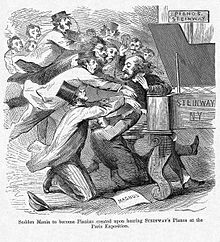 "Sudden Mania to become Pianists created upon hearing Steinway's Pianos at the Paris Exposition."[26]
"Sudden Mania to become Pianists created upon hearing Steinway's Pianos at the Paris Exposition."[26]
This lithograph by Amédée de Noé a.k.a. Cham conveys the wild popularity of the Steinway piano, the musicality of which had just been demonstrated by famed pianist Desiré Magnus, at the 1867 Exposition Universelle in Paris.[26] (Harper's Weekly, August 10, 1867, reporting on the world exposition).The Steinway company and the family members have won numerous awards, including the following:[38][39][160]
- In 1839, Heinrich Engelhard Steinweg exhibited pianos at the State Trade Exhibition at the Aegis Church in Brunswick, won top prize, and made a sale to the Duke.
- In 1854, Steinway attended its first exhibition in the United States – the Metropolitan Mechanics Institute fair in Washington, D.C. Henry Steinway Jr.'s design won 1st Prize.
- In 1855, Steinway exhibited at the American Institute Exhibition in The Crystal Palace at Sixth Avenue and 42nd Street in New York City. There, it won its first Gold Medal "for excellent quality". A reporter wrote the following: "Their square pianos are characterized by great power of tone, a depth and richness in the bass, a full mellowness in the middle register and brilliant purity in the treble, making a scale perfectly equal and singularly melodious throughout its entire range. In touch, they are all that could be desired."
- In 1855–62 Steinway pianos received 35 medals in the United States alone.[23][161]
- In 1862, for the International Exhibition in London, Steinway shipped two square pianos and two grand pianos to England (two to Liverpool and two to London), and won 1st Prize.
- In 1867, at the Exposition Universelle in Paris, Steinway won three awards – the Grand Gold Medal of Honor "for excellence in manufacturing and engineering pianos", the grand annual testimonial medal, and an honorary membership in the Société Nationale des Beaux-Arts. These medals won in Europe increased the demand for Steinway pianos, thus the reason the family looked into opening a store in London. The 1867 Exposition Universelle established Steinway as the leading choice for pianos in Europe.[26]
- In 1876, at the famous Centennial Exposition, Steinway received the two highest awards and a certificate of the judges showing a rating of 95,5 of a possible 96.
- In 1952, Theodore E. Steinway was awarded the first Lichtenstein Medal by the Collectors Club of New York.
- In 2007, the National Medal of Arts was awarded to Henry Z. Steinway and presented by US President George W. Bush on November 15, 2007 in an East Room ceremony at the White House. Henry Z. Steinway received the award for "his devotion to preserving and promoting quality craftsmanship and performance; as an arts patron and advocate for music and music education; and for continuing the fine tradition of the Steinway piano as an international symbol of American ingenuity and cultural excellence." The National Medal of Arts is a presidential initiative managed by the National Endowment for the Arts.
Patented inventions
Steinway has registered around 130 patents so far.[28][29] According to a patent attorney, most of what is needed to know about modern piano manufacturing is covered by Steinway's patented inventions.[162] Some notable examples of Steinway's patents are:
- Patent No. 26,532 (December 20, 1859):[163] The bass strings are "overstrung" above the treble strings to provide more length and better tonal quality. The invention won 1st prize medal at the London Exhibition in 1862.[164] Today, the invention is a standard feature of grand piano construction.[161]
- Patent No. 126,848 (May 14, 1872):[165] Steinway invented the Duplex Scale on the principle of enabling the freely oscillating parts of the string, directly in front of and behind the segment of the string actually struck, also to resound. The outcome is a large range and fullness of overtones – one of the characteristics of the "Steinway sound".
- Patent No. 127,383 (May 28, 1872):[166] In a Steinway piano, the cast iron plate rests on wooden dowels without actually touching the soundboard. It is lightly curved, creating a large hollow between the plate and the soundboard. This cavity acts as a reinforcement of existing resonant properties. An additional function of the plate is to counteract the pull of more than 20 tons of the string tension.
- Patent No. 156,388 (October 27, 1874):[167] Steinway invented the middle piano pedal, called the sostenuto pedal. The sostenuto pedal gives the pianist an ability to create what is called an organ pedal point by keeping a specific note's damper, or notes' dampers, in their open position(s), allowing those strings to continue to sound while other notes can be played without continuing to resonate.
- Patent No. 170,645 (November 30, 1875):[168] Steinway's "regulation action pilot" – also known as the capstan screw, which lifts the parts that drive the hammer toward the string. The Steinway device was adjustable, an advance that simplifies the chore of modifying a piano's action to a pianist's liking. Henry Z. Steinway called that patent the birth of the modern grand piano action.[169]
- Patent No. 233,710 (October 26, 1880):[170] The bridge transmits the vibration of the strings to the soundboard. In a Steinway piano, the bridge consists of vertically glued laminations; a principle that ensures that vibrations are easily developed and forwarded.
- Patent No. 314,742 (March 31, 1885):[171] The inner and outer case comprise up to 18 layers of solid, hard-textured, horizontal-grain timber, pressed and bent into shape in one operation. They turn the case into one of the major components of the entire resonant body. It is a special bending process without the application of either heat or humidity.
- Patent No. 2,051,633 (August 18, 1936):[172] The soundboard resembles a membrane. The special molding, gradually tapering from the center to the edge, provides great flexibility and freer vibration across the board.
- Patent No. 3,091,149 (May 25, 1963):[173] The pin-block is specially designed to keep the instrument in tune longer. Steinway uses six glued layers of hard-textured wood, set at a 45° angle to the run of the grain. In this way, the tuning pins have a strong hold in the pin-block against overall pull and tension.
Documentary film
Main article: Note by Note: The Making of Steinway L1037Note by Note: The Making of Steinway L1037 is an independent documentary film that follows the construction of a Steinway concert grand piano for more than a year, from the search for wood in Alaska to a display at Manhattan's Steinway Hall. The documentary film received its U.S. theatrical premiere at New York's Film Forum in November, 2007.[174][175]
In the documentary, the pianists Pierre-Laurent Aimard, Kenny Barron, Bill Charlap, Harry Connick, Jr., Hélène Grimaud, Hank Jones, Lang Lang and Marcus Roberts, are seen testing and talking about Steinway pianos. The Steinway founder's great-grandson, Henry Z. Steinway, talks about the company's history.[176][177]
Critics gave the documentary mostly positive reviews. As of July 17, 2011[update], the review aggregator Rotten Tomatoes reported that 90% of critics gave the film positive reviews, based on 20 reviews.[175] The documentary has won 7 awards.[178]
Music
Steinway pianos have appeared in numerous records and concerts. A few examples are:
-
Ignacy Jan Paderewski performing on a Steinway[179] grand piano waltz in C sharp minor, Op. 64, No. 2, composed by Frédéric Chopin. (Studio recording from 1917).
-
Sergei Rachmaninoff performing on a Steinway[180] grand piano waltz in E flat major, Op. 18, composed by Frédéric Chopin. (Studio recording from 1921).
-
The White House's Steinway[181] art case grand piano from 1938. Lin-Manuel Miranda (rapping) and Alex Lacamoire (piano) performing The Hamilton Mixtape, composed by Lin-Manuel Miranda, at the White House Evening of Poetry, Music and the Spoken Word. (Concert recording from 2009).
-
Harry Connick, Jr. and his band performing When the Saints Go Marching In. Harry Connick, Jr. plays on a Steinway[182] grand piano. (Concert recording from 2010).
Problems listening to these files? See media help.
References
- ^ a b Good, Edwin M. (2002). Giraffes, black dragons, and other pianos: a technological history from Cristofori to the modern concert grand. Stanford University Press. p. 303. ISBN 9780804745499. http://books.google.com/books?id=8bTaWRWsWngC&lpg=PA303&dq=Steinway%20Musical%20Instruments&hl=da&pg=PA303#v=onepage&q&f=false. Retrieved July 30, 2011.
- ^ Fostle, Donald W. (1995). The Steinway Saga: An American Dynasty. New York: Scribner. p. 25. ISBN 978-0-684-19318-2.
- ^ Merriam-Webster, Inc (2000). Merriam-Webster's Collegiate Encyclopedia. Merriam-Webster, Inc. p. 1540. ISBN 9780877790174. http://books.google.com/books?id=V2d12iZkgOwC&lpg=PP1&dq=9780877790174&hl=da&pg=PA1540#v=onepage&q&f=false. Retrieved July 30, 2011.
- ^ a b Larry Fine (Spring 2011). "Steinway & Sons". Piano Buying Guide 2011. Larry Fine. p. 191. http://www.pianobuyer.com/spring11/191.html. Retrieved August 18, 2011.
- ^ a b c "Authorized Steinway". Garritan. http://www.garritan.com/index.php?option=com_content&view=article&id=105&Itemid=55. Retrieved August 19, 2011.
- ^ a b "Steinway & Sons names Thomas Kurrer as President". Goliath, The Gale Group. August 29, 2007. http://goliath.ecnext.com/coms2/gi_0199-6903086/Steinway-Sons-Names-Thomas-Kurrer.html. Retrieved July 24, 2011.
- ^ a b "Steinway Grand Pianos". Steinway & Sons – American headquarters. http://www.steinway.com/pianos/steinway/grand. Retrieved July 27, 2011.
- ^ a b "Steinway Flügel [Steinway Grand Pianos]" (in German). Steinway & Sons – German headquarters. http://www.steinway.de/pianos/steinway/grand. Retrieved July 27, 2011.
- ^ a b "Steinway Upright Pianos". Steinway & Sons – American headquarters. http://www.steinway.com/pianos/steinway/upright. Retrieved July 27, 2011.
- ^ a b "Steinway Klaviere [Steinway Upright Pianos]" (in German). Steinway & Sons – German headquarters. http://www.steinway.de/pianos/steinway/upright. Retrieved July 27, 2011.
- ^ "Steinway & Sons. A name steeped in history; synonymous with quality, passion and craftsmanship. Steinway sets the standard.". The Gibbs Gillespie 'Upper Class' Magazine, issue 6. Cream Tv & Media Ltd. Autumn/Winter 2009. http://view.digipage.net/?userpath=00000121/00009306/00048607/&page=88. Retrieved July 27, 2011.
- ^ a b "The Steinway Restoration Center". Steinway & Sons. http://restoration.steinway.com. Retrieved July 27, 2011.
- ^ a b Bambarger, Bradley (Spring 2010). "Instrumental Royalty". Listen: Life with Classical Music (ArkivMusic). http://www.listenmusicmag.com/feature/instrumental-royalty.php. Retrieved July 27, 2011.
- ^ Panchyk, Richard (2008). German New York City. Arcadia Publishing. p. 50. ISBN 9780738556802.
- ^ a b c Michael Lenehan (August 1982 and 2003). "The Quality of the Instrument (K 2571 – The Making of a Steinway Grand)". The Atlantic (former The Atlantic Monthly). http://www.sherwinbeach.com/lenehan/K2571.htm. Retrieved July 28, 2011.
- ^ Liebeskind, David (2003). "The Keys To Success". Stern Business – A publication of the Stern School of Business, New York University. Fall/Winter 2003 – "The Producers". New York: Stern School of Business, New York University. pp. 10–15. http://w4.stern.nyu.edu/sternbusiness/fall_winter_2003/keystosuccess.html. Retrieved July 20, 2011.
- ^ Giordano, Sr., Nicholas J. (2010). Physics of the Piano. Oxford, United Kingdom: Oxford University Press. p. 137. ISBN 978-0-19-954602-2.
- ^ Edmondson, Jacqueline (2006). Condoleezza Rice: A biography. The United States: Greenwood Publishing Group. p. 22. ISBN 9780313336072. http://books.google.dk/books?id=YWcX0F0o88cC&lpg=PP1&pg=PA22#v=onepage&q&f=false. Retrieved August 15, 2011.
- ^ Elliott, Alan C. (1998). A daily dose of the American dream: Stories of success, triumph and inspiration. The United States: Thomas Nelson Inc.. ISBN 9781558535923. http://books.google.dk/books?id=OcHMpcliF90C&lpg=PP1&pg=PA9#v=onepage&q&f=false. Retrieved August 15, 2011.
- ^ Ehrlich, Cyril (1990). The Piano: A History. Oxford, United Kingdom: Oxford University Press. p. 47. ISBN 978-0-19-816171-4.
- ^ Derdak, Thomas; Grant, Tina (1997). International Directory of Company Histories. Volume 19. St. James Press. p. 426. ISBN 9781558623538.
- ^ "Steinway & Sons". The Royal Warrant Holders Association. http://www.royalwarrant.org/directory/results.html?category=&grantor=®ion=&pageSize=10&startAt=0&query=Steinway#. Retrieved July 30, 2011.
- ^ a b c d Singer, Aaron (1986). Labor management relations at Steinway & Sons, 1853–1896. Garland. p. 14. ISBN 9780824083717.
- ^ Spillane, Daniel (1892). "Musical Instruments – The Piano-Forte". The Popular Science Monthly. 40. Bonnier Corporation. p. 488. ISSN 0161-7370. http://books.google.dk/books?id=liADAAAAMBAJ&lpg=PA433&pg=PA488#v=onepage&q&f=false. Retrieved July 22, 2011.
- ^ a b Daniell, Charles A. (1895). Musical instruments at the World's Columbian Exposition. Presto Co.. p. 293.
- ^ a b c d "Cartoon of the Day", Harper's Weekly. August 10, 1867. Retrieved July 30, 2011.
- ^ Ratcliffe, Ronald V. (2002). Steinway. San Francisco: Chronicle Books. p. 39. ISBN 978-0-8118-3389-9.
- ^ a b Matthew L. Wald (March 28, 1991). "Steinway Changing Amid Tradition". The New York Times. http://www.nytimes.com/1991/03/28/business/steinway-changing-amid-tradition.html?pagewanted=all. Retrieved July 27, 2011.
- ^ a b "Steinway & Sons – Patents". Google Patent Search. http://www.google.com/patents?q=Steinway+OR+Steinweg+-Grotrian&scoring=2. Retrieved August 18, 2011.
- ^ a b c Larry Fine (Spring 2011). "Boston". Piano Buying Guide 2011. Larry Fine. p. 163. http://www.pianobuyer.com/spring11/163.html. Retrieved July 22, 2011.
- ^ a b c Larry Fine (Spring 2011). "Essex". Piano Buying Guide 2011. Larry Fine. p. 166. http://www.pianobuyer.com/spring11/166.html. Retrieved July 22, 2011.
- ^ a b c Neudorf, Paula; Soon, Weilun. "Recession's Impact". The Last American Grand. http://www.thelastamericangrand.com/recessionsimpact.html. Retrieved September 5, 2011.
- ^ Lieberman, Richard K. (1995). Steinway & Sons. New Haven, Connecticut: Yale University Press. pp. 14–15. ISBN 978-0-300-06364-6.
- ^ Goldenberg, Susan (1996). Steinway: From glory to controversy; the family, the business, the piano. Oakville, Ontario: Mosaic Press. p. 20. ISBN 978-0-88962-607-2.
- ^ "About Steinway". Official website of Steinway & Sons Owners' Magazine. Faircount Media Group. http://www.steinwaypublication.com/about.html. Retrieved June 12, 2011.
- ^ Lieberman, Richard K. (1995). Steinway & Sons. New Haven, Connecticut: Yale University Press. p. 17. ISBN 978-0-300-06364-6.
- ^ a b "Steinway History". Steinway & Sons – United Kingdom. http://www.steinway.co.uk/about/history. Retrieved June 12, 2011.
- ^ a b "Steinway & Sons' double victory – the truth at last". The New York Times. December 5, 1876. http://query.nytimes.com/mem/archive-free/pdf?_r=1&res=9506E3DF163EE73BBC4D53DFB467838D669FDE. Retrieved August 18, 2011.
- ^ a b "Steinway's victory and laurels". The New York Times. October 17, 1876. http://query.nytimes.com/mem/archive-free/pdf?res=9F03E0DC1431E53ABC4F52DFB667838D669FDE. Retrieved August 18, 2011.
- ^ "Street Necrologs of Astoria". Forgotten New York. http://www.forgotten-ny.com/streetnecrology/astorianecro/astoria.html. Retrieved December 21, 2009.
- ^ Steinway, Theodore E. (2005). People and Pianos: A Pictorial History of Steinway & Sons (3rd ed.). Pompton Plains, New Jersey: Amadeus Press. p. 159. ISBN 978-1-57467-112-4.
- ^ a b Wainwright, David (1975). The Piano Makers. Hutchinson. p. 119. ISBN 9780091229504.
- ^ Loesser, Arthur (1954). Men, Women and Pianos: A social History. University of California. p. 553. ISBN 9780486265438.
- ^ Goldenberg, Susan (1996). Steinway: From glory to controversy; the family, the business, the piano. Oakville, Ontario: Mosaic Press. p. 58. ISBN 978-0-88962-607-2.
- ^ Lieberman, Richard K. (1995). Steinway & Sons. New Haven, Connecticut: Yale University Press. p. 48. ISBN 978-0-300-06364-6.
- ^ Lieberman, Richard K. (1995). Steinway & Sons. New Haven, Connecticut: Yale University Press. p. 51. ISBN 978-0-300-06364-6.
- ^ "Steinway Hall Manhattan New York City". http://www.steinwayshowrooms.com/steinway-hall. Retrieved August 19, 2011.
- ^ "Steinway Hall London". http://www.steinwayhall.co.uk. Retrieved August 19, 2011.
- ^ "Steinway-Haus Berlin" (in German). http://www.steinway-berlin.de. Retrieved August 19, 2011.
- ^ "Steinway-Haus Wien (Vienna)" (in German). http://www.steinwayaustria.at/allg_wien.htm. Retrieved August 19, 2011.
- ^ "White House History Timelines: Musical Performances". The White House Historical Association. http://www.whitehousehistory.org/whha_timelines/timelines_musical-performances.html. Retrieved March 18, 2010.
- ^ Distler, Jed (Spring 2010). "Casing the Piano". Listen: Life with Classical Music (ArkivMusic). http://www.listenmusicmag.com/music-in-art/casing-the-piano.php. Retrieved August 21, 2011.
- ^ "Steinway & Sons – Art Case Pianos – Alma-Tadema". Pianoforte (Pty) Ltd. http://www.pianoforte.co.za/instruments/steinway/artcase. Retrieved August 21, 2011.
- ^ Prettejohn, Elizabeth (March 1, 2002). "Lawrence Alma-Tadema and the modern city of ancient Rome". The Art Bulletin.
- ^ Paul Gambaccini (September 29, 2011). "Playing the White House: Entertaining with the US president". BBC News Magazine. http://www.bbc.co.uk/news/magazine-15036571. Retrieved October 4, 2011.
- ^ "Lin-Manuel Miranda Performs at the White House Poetry Jam: 8 of 8". The White House. May 12, 2009. http://www.whitehouse.gov/photos-and-video/video/lin-manuel-miranda-performs-white-house-poetry-jam-8-8?category=93. Retrieved August 21, 2011.
- ^ a b James Barron (April 2, 2004). "A Piano Is Born, Needing Practice; Full Grandness of K0862 May Take Several Concerts to Achieve". The New York Times. http://www.nytimes.com/2004/04/02/nyregion/piano-born-needing-practice-full-grandness-k0862-may-take-several-concerts.html?pagewanted=3&src=pm. Retrieved August 21, 2011.
- ^ "Laura Bush Hosts Preview Of White House Christmas Decorations". LIFE.com. December 5, 2002. http://www.life.com/image/1673764. Retrieved August 21, 2011.
- ^ James Barron (July 15, 2007). "Let's Play Two: Singular Piano". The New York Times. http://www.nytimes.com/2007/07/15/arts/music/15barr.html?n=Top/Reference/Times%20Topics/Organizations/C/Caramoor%20Center%20for%20Music%20and%20the%20Arts. Retrieved August 21, 2011.
- ^ Ratcliffe, Ronald V. (2002). Steinway. San Francisco: Chronicle Books. pp. 49–55. ISBN 978-0-8118-3389-9.
- ^ Tom Hundley (April 30, 2008). "Aftermath favored Steinway". Chicago Tribune. http://articles.chicagotribune.com/2008-04-30/features/0804280403_1_steinway-sons-piano-making-factory. Retrieved August 21, 2011.
- ^ a b Giordano, Sr., Nicholas J. (2010). Physics of the Piano. Oxford, United Kingdom: Oxford University Press. p. 148. ISBN 978-0-19-954602-2.
- ^ Reuters (September 14, 1985). "CBS Steinway Sale". The New York Times. http://query.nytimes.com/gst/fullpage.html?res=9D05EFDC1639F937A2575AC0A963948260. Retrieved June 1, 2007.
- ^ "About the company", Steinway Musical Instruments Website. Retrieved January 31, 2009.
- ^ "Steinway's Dual Class Voting Structure to be Eliminated". Waltham, Massachusetts: Steinway Musical Instruments. April 29, 2011. http://www.steinwaymusical.com/images/newsfiles/137603Steinways%20Dual%20Class%20Voting%20Structure%20to%20be%20Eliminated.pdf. Retrieved July 18, 2011.
- ^ "Jong Sup Kim – Age: 63". Board of Directors. Steinway Musical Instruments. http://www.steinwaymusical.com/board.php?id=14. Retrieved July 18, 2011.
- ^ "Sir Edward Heath". The Telegraph. July 18, 2005. http://www.telegraph.co.uk/news/obituaries/1494246/Sir-Edward-Heath.html. Retrieved July 20, 2011.
- ^ Kopf, Silas (2008). A marquetry odyssey: Historical objects and personal work. Hudson Hills. p. 169. ISBN 9781555952877. http://books.google.dk/books?id=PQ6NOM12sygC&lpg=PP1&pg=PA169#v=onepage&q&f=false. Retrieved August 25, 2011.
- ^ "Steinway and Sons Unique 500,000th Piano Visits KU (Kansas University)". Official website of University of Kansas. September 26, 2001. http://music.ku.edu/news/2001/20010926-steinway-and-sons-unique-500000th-piano-visits-ku.shtml. Retrieved August 25, 2011.
- ^ a b "Piano Stories Episode 3: One-Of-A-Kind Steinway #500,000". Gather. April 20, 2006. http://www.gather.com/viewArticle.action?articleId=281474976745970. Retrieved August 25, 2011.
- ^ "Timeless Values – Instruments that made history". 150 years Steinway & Sons – The standard of excellence. Steinway & Sons – German headquarters. 2003. p. 15.
- ^ "Steinway & Sons History". Official website of Steinway showrooms. http://www.steinwayshowrooms.com/about-us/steinway-history. Retrieved August 16, 2011.
- ^ a b "What is Excellence?". Lyra – The Music Magazine. 2. Steinway & Sons – German headquarters. 2007. p. 9.
- ^ "Luxury Marketing Council launching Austin chapter". American City Business Journals: Austin Business Journal. October 23, 2008. http://www.bizjournals.com/austin/stories/2008/10/20/daily43.html. Retrieved August 25, 2011.
- ^ "Steinway & Sons History". Steinway Hall London. http://www.steinwayhall.co.uk/about-us/steinway-history. Retrieved August 25, 2011.
- ^ a b c "The S.L.ED by Karl Lagerfeld". Steinway & Sons. http://www.steinway.com/pianos/steinway/limited-edition/karl-lagerfeld. Retrieved August 25, 2011.
- ^ Linda Tagliaferro. "Steinway & Sons Piano Gallery of Long Island". About.com / The New York Times Company. http://longisland.about.com/od/shoppingservices/p/steinway.htm. Retrieved August 25, 2011.
- ^ "Air and Simple Gifts – John Williams". YouTube. January 20, 2009. http://www.youtube.com/watch?v=9k6h48Kcxe8. Retrieved August 24, 2011.
- ^ a b "The 125th Anniversary". Steinway & Sons. http://www.steinway.com/pianos/steinway/limited-edition/the-125th-anniversary. Retrieved August 25, 2011.
- ^ Diane Cole (June 6, 2003). "Fanfare for the Uncommon Piano". The New York Times. http://www.nytimes.com/2003/06/06/arts/fanfare-for-the-uncommon-piano.html. Retrieved August 25, 2011.
- ^ James Barron (September 18, 2008). "Henry Z. Steinway, Piano Maker, Dies at 93". The New York Times. http://www.nytimes.com/2008/09/19/arts/music/19steinway.html. Retrieved August 25, 2011.
- ^ Kathryn J. Siranosian (November 17, 2010). "Step 21: Steinway Installs World's Largest Solar-Powered Cooling System". 1000 Green Steps / Cosmo Fair Network. http://1000greensteps.org/2010/11/17/step-21-steinway-installs-worlds-largest-solar-powered-cooling-system. Retrieved August 25, 2011.
- ^ SI Staff (January 27, 2009). "Steinway Solar Cooling System Is Largest In The World". Solar Industry. Zackin Publications Inc.. http://www.solarindustrymag.com/e107_plugins/content/content.php?content.2434. Retrieved August 25, 2011.
- ^ "Our pianos – Steinway". Steinway & Sons – American headquarters. http://www.steinway.com/steinway. Retrieved August 29, 2011.
- ^ "Instrumente – Steinway [Instruments – Steinway]" (in German). Steinway & Sons – German headquarters. http://www.steinway.de/pianos/steinway. Retrieved August 29, 2011.
- ^ "Louis Comfort Tiffany and Laurelton Hall – An Artist's Country Estate". The Metropolitan Museum of Art. http://www.metmuseum.org/special/tiffany_laurelton/view_1.asp?item=3. Retrieved August 29, 2011.
- ^ a b c "Alma-Tadema". Steinway & Sons. http://www.steinway.com/pianos/steinway/art-case/alma-tadema. Retrieved August 29, 2011.
- ^ a b "Decorative Arts – 3 of 11". Sterling and Francine Clark Art Institute. http://www.clarkart.edu/museum/collections/dec_arts/content.cfm?ID=3&marker=3&start=3. Retrieved August 29, 2011.
- ^ "Steinway Grand Piano". The White House Historical Association. http://www.whitehousehistory.org/whha_about/whitehouse_collection/whitehouse_collection-object-09.html. Retrieved August 29, 2011.
- ^ a b c d Mohit Joshi (May 11, 2008). "Steinway & Sons unveils most expensive piano". Topnews. Manas Informatics Pvt. Ltd.. http://www.topnews.in/steinway-sons-unveils-most-expensive-piano-284306. Retrieved August 29, 2011.
- ^ a b c d "November: 'Art' piano is Expo musical key". Shme – Today's Shanghai. http://www.shme.com/today/2008/november.htm. Retrieved August 29, 2011.
- ^ a b "'Sound of Harmony' piano to make Expo music". Expo 2010 Shanghai China. Tencent Inc. November 29, 2008. http://en.expo2010.cn/a/20081129/000002.htm. Retrieved August 29, 2011.
- ^ "150th Anniversary". Steinway & Sons. http://www.steinway.co.uk/pianos/steinway/limited-edition/150th-anniversary. Retrieved August 29, 2011.
- ^ "William E. Steinway". Steinway & Sons. http://www.steinway.com/pianos/steinway/limited-edition/william-e-steinway. Retrieved August 29, 2011.
- ^ "The Crown Jewels Collection". Steinway & Sons. http://www.steinway.co.uk/pianos/steinway/crown-jewels. Retrieved August 29, 2011.
- ^ a b c d "Concert and Artist Piano Bank". 2010 Annual Report on Form 10-K. Steinway Musical Instruments. March 14, 2011. http://phx.corporate-ir.net/External.File?item=UGFyZW50SUQ9NDE4NDEyfENoaWxkSUQ9NDMxMzg4fFR5cGU9MQ==&t=1. Retrieved August 31, 2011.
- ^ "An enduring Classic – Steinway & Sons: History in the Playing". Steinway & Sons 150th Anniversary Official Publication. Faircount Ltd.. 2003. p. 32.
- ^ "About Steinway Hall". Official website of Steinway showrooms. Steinway & Sons. http://www.steinwayshowrooms.com/steinway-hall/about. Retrieved August 31, 2011.
- ^ "Mikhail Pletnev – biography, concert and CD reviews". www.cosmopolis.ch – Louis Gerber. December 2000. http://www.cosmopolis.ch/english/cosmo12/pletnev.htm. Retrieved August 31, 2011.
- ^ a b c James Barron (August 27, 2003). "Steinways With German Accents; Pianos Made in Queens Have Cousins in Hamburg". The New York Times. http://www.nytimes.com/2003/08/27/nyregion/steinways-with-german-accents-pianos-made-in-queens-have-cousins-in-hamburg.html. Retrieved August 31, 2011.
- ^ William Grimes (June 2, 1993). "Too Many Musicians? An Overhaul at Juilliard -- A special report.; A New Juilliard for a More Challenging Era". The New York Times. http://www.nytimes.com/1993/06/02/arts/too-many-musicians-overhaul-juilliard-special-report-new-juilliard-for-more.html. Retrieved August 31, 2011.
- ^ "Emanuel Ax". The Juilliard School. http://www.juilliard.edu/degrees-programs/music/faculty/detail.php?FacultyId=1. Retrieved August 31, 2011.
- ^ "World's Finest Pianos", Steinway & Sons Official Website, 2007. Retrieved June 1, 2007.
- ^ "About Us", Steinway Musical Instruments, Inc., 2007. Retrieved June 2, 2007.
- ^ "What is black and white and made in Queens?", The New York Times, November 7, 2007. Retrieved August 17, 2011.
- ^ "Steinway pianos", Steinway & Sons Official Website. Retrieved March 11, 2010.
- ^ "A Quality Piano Starts with Quality Wood", Steinway Hall – Dallas/Fort Worth/Plano, Official Website. Retrieved June 12, 2011.
- ^ "Rim Bending Process", Steinway Hall – Dallas/Fort Worth/Plano, Official Website. Retrieved June 12, 2011.
- ^ a b "Coming Together: Fitting The Soundboard & Plate to the Pianos Rim", Steinway Hall – Dallas/Fort Worth/Plano, Official Website. Retrieved March 16, 2010.
- ^ a b Fx: "Specifications and Features – Model D", Steinway & Sons Official Website. Retrieved September 6, 2009.
- ^ "Steinway & Sons pianos", Pianissimo Pianoforte. Retrieved August 17, 2011.
- ^ "The Steinway Soundboard", Steinway Hall – Dallas/Fort Worth/Plano, Official Website. Retrieved June 12, 2011.
- ^ a b c Piano Buyer's Guide, p. 13.
- ^ "Soundboard for pianos...", Google Patents Website. Retrieved April 18, 2009.
- ^ "Patent No. 26,532", Google Patent Search.
- ^ a b c d "Specifications and Features", Steinway & Sons Official Website. Retrieved June 4, 2009.
- ^ Piano Buyer's Guide, p. 14.
- ^ Lieberman, Richard K. (1995). Steinway & Sons. New Haven, Connecticut: Yale University Press. pp. 56–58. ISBN 978-0-300-06364-6.
- ^ Steinway & Sons – 150 Years, p. 80.
- ^ a b "Just about perfect: The dichotomy of Steinway piano design", STEP Inside Design, issue of November/December 2003, p. 68.
- ^ "Steinway sets the stage", Steinway & Sons Official Website. Retrieved July 16, 2011.
- ^ A Steinway poster and the magazine Lyra – 1/04, p. 12.
- ^ Steinway & Sons – 150 Years, p. 148–157.
- ^ Steinway Artists, Steinway & Sons Official Website. Retrieved October 11, 2010.
- ^ a b "The Artists' Choice", Steinway & Sons Official Website. Retrieved December 21, 2009.
- ^ "Over 1,600 Steinway Artists", Steinway & Sons Official Website. Retrieved July 16, 2011.
- ^ a b Giordano, Sr., Nicholas J. (2010). Physics of the Piano. Oxford, United Kingdom: Oxford University Press. p. 146. ISBN 978-0-19-954602-2.
- ^ "Steinway Artists – Immortals", Steinway & Sons Official Website. Retrieved July 16, 2011.
- ^ "Steinway Artists – Ensembles", Steinway & Sons Official Website. Retrieved July 16, 2011.
- ^ "Young Steinway Artists", Steinway & Sons Official Website. Retrieved June 12, 2011.
- ^ "MUSIC; Piano Versus Piano", The New York Times, May 9, 2004. Retrieved June 20, 2009.
- ^ "Maestro Music Pianos", Maestro Music Pianos Website. Retrieved January 13, 2009.
- ^ a b c d "Piano Versus Piano", The New York Times, May 9, 2004. Retrieved March 23, 2008.
- ^ Booklet on new Steinway Artists and earlier Steinway Artists: Steinway Artists – Steinway Künstler, 2003/2004.
- ^ E.g.: "Pianists", Bechstein Official Website. Retrieved June 12, 2011.
- ^ E.g.: "Reference List", Bösendorfer Official Website. Retrieved March 23, 2010.
- ^ "The Artists' Choice", Steinway & Sons Official Website. Retrieved March 23, 2010.
- ^ a b c "All-Steinway Schools", Steinway & Sons Official Website. Retrieved June 12, 2011.
- ^ "Celebrating over 125 All-Steinway Schools", Steinway & Sons Official Website. Retrieved June 12, 2011.
- ^ a b "All-Steinway Schools", YouTube. April 23, 2011.
- ^ "Oberlin and Steinway: A 122-Year Partnership", Oberlin Conservatory News, 1999. Retrieved June 1, 2007.
- ^ "GW Today", GW Goes All Steinway: Largest Gift in Music Department History sets GW apart. Retrieved August 2, 2010.
- ^ "UF School of Music enters new decade as 'All-Steinway School'", University of Florida News, 2009. Retrieved December 25, 2009.
- ^ "About The Crane School of Music", State University of New York at Potsdam Website. Retrieved August 3, 2010.
- ^ "College-Conservatory of Music Giving Initiatives – Funding Opportunities – Steinway Initiative", University of Cincinnati Website. Retrieved August 17, 2011.
- ^ "CCM joins Steinway & Sons in historic partnership", Steinway & Sons Official Website. Retrieved August 17, 2011.
- ^ "CBS Sunday Morning, about University of Cincinnati College-Conservatory of Music becoming an All-Steinway School", YouTube. September 30, 2009.
- ^ a b "Piano Competitions", Steinway Musical Instruments Official Website. Retrieved June 13, 2011.
- ^ "Der Steinway Klavierspiel-Wettbewerb", Steinway-Haus Hamburg Website. Retrieved August 16, 2011. (German)
- ^ "Steinway Young Artist Competition", Steinway Young Artist Competition Website. Retrieved January 2, 2010.
- ^ "Steinway Piano Festival – Portal", Juhl-Sørensen A/S – authorized Steinway dealer. Retrieved January 2, 2010. (Danish)
- ^ "Steinway Societies", Steinway Musical Instruments Official Website. Retrieved June 12, 2011.
- ^ "Sound of Harmony", Steinway & Sons Official Website. Retrieved August 16, 2011.
- ^ Article: "Lawrence Alma-Tadema and the modern city of ancient Rome. (Critical Essay)". Gale, March 1, 2002.
- ^ "Alma-Tadema", Steinway & Sons Website, 2009. Retrieved January 13, 2009.
- ^ Eight Keys to Buying a Piano – A guide to selecting the perfect instrument, p. 10.
- ^ "Sir Lawrence Alma-Tadema – British, 1836–1912 – Sir Edward John Poynter – Steinway & Sons", Clark Art Institute. Retrieved March 16, 2010.
- ^ "Two Million Dollars For A Piano...Imagine That", Forbes.com, 2000. Retrieved May 26, 2009.
- ^ "BBC News", BBC Website, 2009. Retrieved January 13, 2009.
- ^ Lyra – 2/07, p. 3.
- ^ a b Tradition, Innovation, Perfection – From Instrument No. 1 to Today: 13.
- ^ Forbes Magazine: "Ode to a Steinway", 07.28.1997, vol. 160, issue 2, p. 266–267.
- ^ "Patent number: 26,532", Google Patent Search.
- ^ Robert Palmieri and Margaret W. Palmieri: Piano – an encyclopedia, p. 77–78.
- ^ "Patent number: 126,848", Google Patent Search.
- ^ "Patent number: 127,383", Google Patent Search.
- ^ "Patent number: 156,388", Google Patent Search.
- ^ "Patent number: 170,645", Google Patent Search.
- ^ Barron, James (2006). Piano: The Making of a Steinway Concert Grand. New York: Holt. p. 105. ISBN 978-0-8050-7878-7.
- ^ "Patent number: 233,710", Google Patent Search.
- ^ "Patent number: 314,742", Google Patent Search.
- ^ "Patent number: 2,051,633", Google Patent Search.
- ^ "Patent number: 3,091,149", Google Patent Search.
- ^ "Note by Note: The Making of Steinway L1037", Film Forum. Retrieved March 13, 2010.
- ^ a b "Note by Note: The Making of the Steinway L1037 (2007)", Rotten Tomatoes. Retrieved June 12, 2011.
- ^ "Note by Note: The Making of Steinway L1037", IMDb.com. Retrieved March 12, 2010.
- ^ "Note By Note: The Making of Steinway L1037 (2007)", The New York Times. Retrieved March 12, 2010.
- ^ Official Website of "Note by Note: The Making of Steinway L1037", press.
- ^ According to the little book in the CD cover of the album Paderewski plays Chopin – Volume 1 from the label Pearl the piano is a "Steinway grand". Paderewski was very associated with Steinway, he and William Steinway together created the program called Steinway Artists.
- ^ According to the back of the CD's cover of Sergej Rachmaninov Piano Recital: "Piano: Steinway & Sons Grand Piano".
- ^ "Lin-Manuel Miranda Performs at the White House Poetry Jam: 8 of 8", White House Official Website, May 12, 2009. Retrieved August 7, 2011.
- ^ "Harry Connick, Jr. at the White House", White House Official Website, February 21, 2010. Retrieved August 23, 2011.
Further reading
- Barron, James (2006). Piano: The Making of a Steinway Concert Grand. New York: Holt. ISBN 978-0-8050-7878-7.
- Chapin, Miles (1997). 88 keys: The making of a Steinway piano. New York: Potter. ISBN 978-0-517-70356-4.
- Ehrlich, Cyril (1990). The Piano: A History. Oxford, United Kingdom: Oxford University Press. ISBN 978-0-19-816171-4.
- Fine, Larry (2007). 2007–2008 Annual Supplement to The Piano Book. Jamaica Plain, Massachusetts: Brookside Press. pp. 13–14, 96–100, 184–187. ISBN 978-1-929145-21-8.
- Fine, Larry (2001). The Piano Book: Buying & Owning a New or Used Piano (4th revised ed.). Jamaica Plain, Massachusetts: Brookside Press. ISBN 978-1-929145-01-0.
- Fostle, Donald W. (1995). The Steinway Saga: An American Dynasty. New York: Scribner. ISBN 978-0-684-19318-2.
- Giordano, Sr., Nicholas J. (2010). Physics of the Piano. Oxford, United Kingdom: Oxford University Press. ISBN 978-0-19-954602-2.
- Goldenberg, Susan (1996). Steinway: From glory to controversy; the family, the business, the piano. Oakville, Ontario: Mosaic Press. ISBN 978-0-88962-607-2.
- Hoover, Cynthia Adams (1981). "The Steinways and Their Pianos in the Nineteenth Century". Journal of the American Musical Instrument Society. 7. Shreveport, Louisiana: American Musical Instrument Society. pp. 47–89. ISSN 0362-3300.
- Kehl, Roy F.; Kirkland, David R. (2011). The Official Guide to Steinway Pianos. Montclair, New Jersey: Amadeus Press. ISBN 978-1-57467-198-8.
- Lieberman, Richard K. (1995). Steinway & Sons. New Haven, Connecticut: Yale University Press. ISBN 978-0-300-06364-6.
- Matthias, Max (2006). Steinway Service Manual: Guide to the care and maintenance of a Steinway (3rd ed.). Bergkirchen, Germany: PPV-Medien/Bochinsky. ISBN 978-3-923639-15-1.
- Ratcliffe, Ronald V. (2002). Steinway. San Francisco: Chronicle Books. ISBN 978-0-8118-3389-9.
- Steinway, Theodore E. (2005). People and Pianos: A Pictorial History of Steinway & Sons (3rd ed.). Pompton Plains, New Jersey: Amadeus Press. ISBN 978-1-57467-112-4.
External links
- Official website of Steinway's headquarters in New York City
- Official website of Steinway's headquarters in Hamburg (German)
- Nine-part series in The New York Times following the construction of a Steinway concert grand piano at the factory in New York City (May 11, 2003 to April 2, 2004)
- Article in The Atlantic (former The Atlantic Monthly) (August 1982 and March 1997)
- Article in Stern Business – A publication of the Stern School of Business, New York University (Fall/Winter 2003)
- Article in STEP Inside Design (November/December 2003)
- The Steinway & Sons Collection in La Guardia and Wagner Archives (see also the section Steinway & Sons in the article La Guardia and Wagner Archives)
- About the Steinway family, company and village on the website of Greater Astoria Historical Society (see also the article Greater Astoria Historical Society)
- Video showing an inside view of a Steinway concert grand piano
Steinway & Sons C.F. Theodore Steinway · Henry E. Steinway (founder) · Henry Z. Steinway · John H. Steinway · Theodore E. Steinway · William Steinway
Note by Note: The Making of Steinway L1037 · Steinway D-274 · Steinway Hall · Steinway Mansion · Steinway Musical Instruments · Steinway Street
Categories:- Steinway & Sons
- American brands
- British Royal Warrant holders
- Buildings and structures in Hamburg
- Buildings and structures in New York City
- Companies based in Hamburg
- Companies based in New York City
- Companies established in 1853
- Former CBS Corporation subsidiaries
- German brands
- Luxury brands
- Manufacturing companies based in New York
- Manufacturing companies of Germany
- Musical instrument makers
- Piano manufacturing companies
- Purveyors to the Court of Sweden
- Purveyors to the Imperial and Royal Court
- Saxon Royal Warrant holders
- Spanish Royal Warrant holders
Wikimedia Foundation. 2010.

